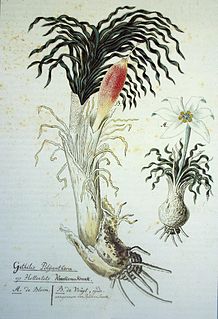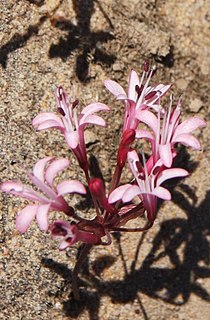
Gethyllis, commonly called Kukumakranka, Koekemakranka, or Kroekemakrank, is a genus of bulbous plant in the Amaryllid family with some 33 accepted species.. It is native to the Cape Provinces, the Northern Provinces and the Free State of South Africa, as well as Botswana and Namibia.

Psammophora is a genus of plant in the family Aizoaceae.

Strumaria is a genus of African plants in Amaryllis family, subfamily Amaryllidoideae. The genus is known in nature only from South Africa, Lesotho and Namibia. Almost all species flower in the autumn and are cultivated as ornamental bulbous plants.
Strumaria hardyana is a species of plant that is endemic to Namibia. Its natural habitats are subtropical or tropical dry shrubland and rocky areas. It is one of the three species of Strumaria with nodding rather than outward-facing flowers. It can be distinguished from the similar species Strumaria truncata by the narrow membranous margin to the leaves, which are not twisted.

Albuca is a genus of flowering plants in the family Asparagaceae, subfamily Scilloideae. The genus is distributed mainly in southern and eastern Africa, with some species occurring in northern Africa and the Arabian Peninsula. Plants of the genus are known commonly as slime lilies.

Cassine is a genus of trees, of the plant family Celastraceae.

Hessea is a genus of bulb-forming plants in the Amaryllis family native to Namibia and South Africa. The genus name commemorates C. H. F. Hesse (1772–1832), who resided in Cape Town from 1800 to 1817.
Strumaria unguiculata is a plant species endemic to Western Cape Province in South Africa.

Amaryllideae are a tribe of subfamily Amaryllidoideae. They are herbaceous monocot perennial flowering plants with a predominantly Southern African distribution, with the exception of the pantropical genus Crinum. They are generally treated as consisting of four subtribes. In addition to Crinum, other genera include Amaryllis, Boophone and Strumaria.

Conophytum bilobum is a plant in the family Aizoaceae, native to southern South Africa. It blooms in autumn. It is scentless and grows to a height of 7 cm (2.8 in). The specific epithet bilobum comes from the two-lobed bodies these plants possess.

Strumariinae is one of four subtribes within the tribe Amaryllideae, found in southern Africa.
Strumaria massoniella is a species of flowering plant in the family Amaryllidaceae, native to the Cape Provinces of South Africa. It was first described in 1985 as Gemmaria massoniella. Its bulb is solitary. Like other members of the genus Strumaria it has star-shaped flowers. In the Northern Cape Province, it is found in sandy plains at an elevation of about 1,000 m (3,300 ft).

Strumaria tenella is a species of flowering plant in the family Amaryllidaceae, native to Lesotho, and the Cape Provinces and Free State of South Africa. It was first described by Carl Linnaeus the Younger in 1782 as Crinum tenellum. Its inflorescence of white flowers has been described as "noticeably starry".










